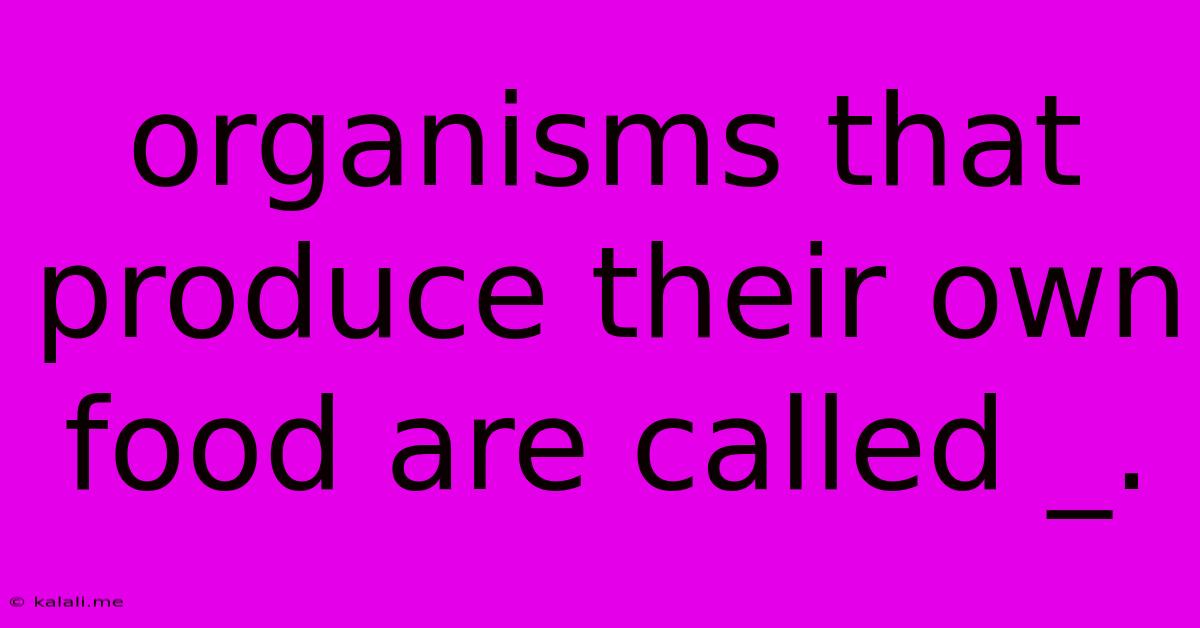Organisms That Produce Their Own Food Are Called _.
Kalali
Jun 12, 2025 · 3 min read

Table of Contents
Organisms That Produce Their Own Food Are Called Autotrophs
Organisms that produce their own food are called autotrophs. This ability to self-feed is a fundamental characteristic distinguishing them from heterotrophs, which obtain their energy by consuming other organisms. Understanding autotrophs is crucial to grasping the basic functioning of ecosystems and the intricate web of life on Earth. This article will delve deeper into the fascinating world of autotrophs, exploring their methods of food production, their ecological significance, and some common examples.
What are Autotrophs?
The term "autotroph" comes from the Greek words "auto" (self) and "troph" (nourishment). These organisms are also often referred to as producers because they form the base of most food chains. Instead of relying on external sources of organic carbon for nutrition, autotrophs synthesize their own organic compounds from inorganic substances. This process is primarily driven by capturing energy from either sunlight (photosynthesis) or chemical reactions (chemosynthesis).
Two Main Types of Autotrophs:
Autotrophs are broadly categorized into two types based on their energy source:
1. Photoautotrophs: Harnessing the Power of Sunlight
Photoautotrophs, the most common type of autotroph, use sunlight as their primary energy source for photosynthesis. Photosynthesis is a complex process involving chlorophyll and other pigments that capture light energy and convert it into chemical energy in the form of glucose. This glucose serves as the building block for all other organic molecules essential for growth and survival. Plants, algae, and cyanobacteria are prime examples of photoautotrophs. They are crucial for maintaining atmospheric oxygen levels and forming the foundation of most terrestrial and aquatic food webs.
2. Chemoautotrophs: Energy from Chemical Reactions
Chemoautotrophs, unlike photoautotrophs, derive their energy from the oxidation of inorganic compounds. They typically thrive in environments lacking sunlight, such as deep-sea hydrothermal vents or sulfur springs. These organisms utilize chemical energy to synthesize organic molecules, often utilizing compounds like hydrogen sulfide, ammonia, or ferrous iron as electron donors. Chemoautotrophs play a vital role in nutrient cycling in extreme environments, supporting unique ecosystems independent of solar energy.
The Importance of Autotrophs in Ecosystems:
Autotrophs are undeniably critical to the health and balance of ecosystems. Their primary role as producers makes them the cornerstone of most food chains. They provide the primary source of energy and organic matter for:
- Herbivores: Animals that directly consume plants or algae.
- Carnivores: Animals that feed on herbivores or other carnivores.
- Decomposers: Organisms like fungi and bacteria that break down organic matter, returning nutrients to the environment.
Without autotrophs, the flow of energy and nutrients through ecosystems would cease, leading to a collapse of biodiversity and the overall stability of the environment.
Examples of Autotrophs:
Here are some common examples of autotrophs belonging to different kingdoms:
- Kingdom Plantae: Trees, grasses, flowering plants, ferns
- Kingdom Protista: Algae (e.g., kelp, diatoms)
- Kingdom Monera (Bacteria): Cyanobacteria (blue-green algae)
- Archaea: Various chemoautotrophic archaea found in extreme environments.
In conclusion, understanding the role of autotrophs is essential for comprehending the intricate workings of our planet's ecosystems. Their unique ability to synthesize their own food forms the basis of almost all food chains, supporting a vast array of life forms. Further research into the diversity and mechanisms of autotrophs continues to unlock fascinating insights into the fundamental processes of life itself.
Latest Posts
Latest Posts
-
Which Of The Following Statements About Monetary Policy Is True
Jun 13, 2025
-
What Is The Lcm Of 8 12 15
Jun 13, 2025
-
Which Installation Is Not Covered By The Code
Jun 13, 2025
-
The Largest Portion Of Earths Volume Is
Jun 13, 2025
-
The Device That Connects Two Networks Is A
Jun 13, 2025
Related Post
Thank you for visiting our website which covers about Organisms That Produce Their Own Food Are Called _. . We hope the information provided has been useful to you. Feel free to contact us if you have any questions or need further assistance. See you next time and don't miss to bookmark.